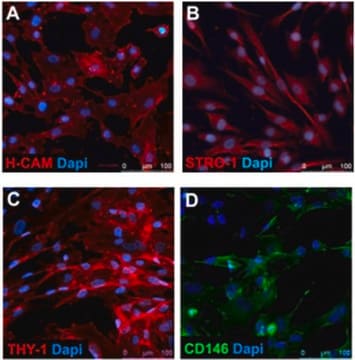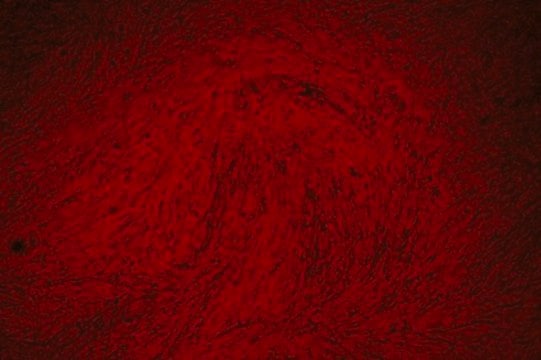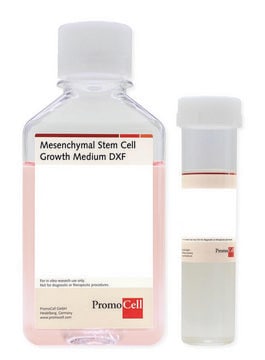SCC034
Human Mesenchymal Stem Cells (Bone Marrow)
Human mesenchymal stem cells derived from bone marrow that have a capacity for expansion in vitro while maintaining their potential for differentiation to multiple lineages including adipocytes, osteoblasts and chondrocytes.
Synonym(s):
Human Bone Marrow MSCs, Human Bone Marrow Multipotent Stem Cells, Human MSCs
Sign Into View Organizational & Contract Pricing
All Photos(4)
About This Item
UNSPSC Code:
41106509
eCl@ss:
32011203
NACRES:
NA.75
Recommended Products
biological source
human
Quality Level
technique(s)
cell culture | mammalian: suitable
cell culture | stem cell: suitable
cell differentiation: suitable
input
sample type mesenchymal stem cell(s)
shipped in
liquid nitrogen
General description
Mesenchymal stem cells, also known as marrow stromal cells, are defined as a self-renewing population of adherent, bone-marrow-derived multipotent progenitor cells with the capacity to differentiate into several mesenchymal cell lineages. In defined cultures in vitro, mesenchymal stem cells have been shown to readily differentiate into lineage-specific cells that form bone, cartilage, fat, tendon, and muscle tissues.
EMD Millipore’s Human Mesenchymal Stem Cells (Bone Marrow) are isolated from normal human bone marrow and are cryopreserved at P2 to ensure optimal phenotype and the highest viability and plating efficiency. These cells proliferate as an adherent cell monolayer and have shown a strong capacity for expansion in vitro while maintaining their potential for differentiation to multiple lineages including adipocytes, osteoblasts and chondrocytes..
EMD Millipore’s Human Mesenchymal Stem Cells (Bone Marrow) are isolated from normal human bone marrow and are cryopreserved at P2 to ensure optimal phenotype and the highest viability and plating efficiency. These cells proliferate as an adherent cell monolayer and have shown a strong capacity for expansion in vitro while maintaining their potential for differentiation to multiple lineages including adipocytes, osteoblasts and chondrocytes..
Cell Line Description
Mesenchymal Stem Cells
Application
Research Category
Stem Cell Research
Stem Cell Research
Components
1X106 viable Human Bone Marrow Mesenchymal Stem Cells
Quality
- Each vial contains at least 1X10⁶ viable cells at P2.
- Cell viability is greater than 75% at thaw and cells can be cultured for at least 3 population doublings after the initial thaw.
- Bone marrow donors tested negative for HIV, hepatitis B and hepatitis C.
- Apparently normal karyotype per cytogenetic analysis.
- Cells tested negative for mycoplasma contamination.
- Cell viability is greater than 75% at thaw and cells can be cultured for at least 3 population doublings after the initial thaw.
- Bone marrow donors tested negative for HIV, hepatitis B and hepatitis C.
- Apparently normal karyotype per cytogenetic analysis.
- Cells tested negative for mycoplasma contamination.
Storage and Stability
Human Mesenchymal Stem Cells (Bone Marrow) should be stored in liquid nitrogen. The cells are guaranteed for at least 3 population doublings without significantly affecting cell surface marker expression and differentiation potential.
Disclaimer
RESEARCH USE ONLY. This product is regulated in France when intended to be used for scientific purposes, including for import and export activities (Article L 1211-1 paragraph 2 of the Public Health Code). The purchaser (i.e. enduser) is required to obtain an import authorization from the France Ministry of Research referred in the Article L1245-5-1 II. of Public Health Code. By ordering this product, you are confirming that you have obtained the proper import authorization.
Unless otherwise stated in our catalog or other company documentation accompanying the product(s), our products are intended for research use only and are not to be used for any other purpose, which includes but is not limited to, unauthorized commercial uses, in vitro diagnostic uses, ex vivo or in vivo therapeutic uses or any type of consumption or application to humans or animals.
Storage Class Code
10 - Combustible liquids
WGK
WGK 3
Flash Point(F)
Not applicable
Flash Point(C)
Not applicable
Certificates of Analysis (COA)
Search for Certificates of Analysis (COA) by entering the products Lot/Batch Number. Lot and Batch Numbers can be found on a product’s label following the words ‘Lot’ or ‘Batch’.
Already Own This Product?
Find documentation for the products that you have recently purchased in the Document Library.
Customers Also Viewed
LncRNA-NEF is downregulated in postmenopausal osteoporosis and is related to course of treatment and recurrence.
Xiaoyong Ma et al.
The Journal of international medical research, 47(7), 3299-3306 (2019-06-22)
Christy Wing Tung Wong et al.
Stem cell research & therapy, 13(1), 419-419 (2022-08-14)
Critical limb ischemia (CLI) is the most severe form of peripheral artery disease and exhibits a high risk of lower extremity amputations. As even the most promising experimental approaches based on mesenchymal stem cells (MSCs) demonstrated only moderate therapeutic effects
Diego Omar Sanchez Ramirez et al.
Bioengineering (Basel, Switzerland), 8(12) (2021-12-24)
Protein-based nanofibres are commonly used in the biomedical field to support cell growth. For this study, the cell viability of wool keratin-based nanofibres was tested. Membranes were obtained by electrospinning using formic acid, hexafluoroisopropanol, and water as solvents. For aqueous
Ramona Orlacchio et al.
Molecules (Basel, Switzerland), 27(7) (2022-04-13)
Poly-L-lactic acid (PLLA) aerogel-based scaffolds were obtained from physical PLLA gels containing cyclopentanone (CPO) or methyl benzoate (BzOMe) molecules. An innovative single step method of solvent extraction, using supercritical CO2, was used to achieve cylindrical monolithic aerogels. The pore distribution
Iriczalli Cruz-Maya et al.
Journal of functional biomaterials, 14(1) (2023-01-21)
In the last decade, alginate-based microgels have gained relevant interest as three-dimensional analogues of extracellular matrix, being able to support cell growth and functions. In this study, core-shell microgels were fabricated by self-polymerization of dopamine (DA) molecules under mild oxidation
Our team of scientists has experience in all areas of research including Life Science, Material Science, Chemical Synthesis, Chromatography, Analytical and many others.
Contact Technical Service









